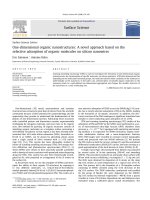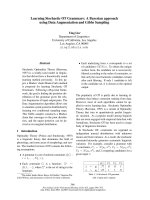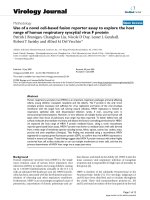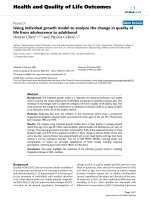A novel approach, using regional climate model, to derive present and future intensity duration frequency curves
Bạn đang xem bản rút gọn của tài liệu. Xem và tải ngay bản đầy đủ của tài liệu tại đây (26.35 MB, 480 trang )
A NOVEL APPROACH,
USING REGIONAL CLIMATE MODEL,
TO DERIVE PRESENT AND FUTURE
INTENSITY-DURATION-FREQUENCY CURVES
LIEW SAN CHUIN
NATIONAL UNIVERSITY OF SINGAPORE
2012
A NOVEL APPROACH,
USING REGIONAL CLIMATE MODEL,
TO DERIVE PRESENT AND FUTURE
INTENSITY-DURATION-FREQUENCY CURVES
LIEW SAN CHUIN
(B.Eng.(Hons), USM)
A THESIS SUBMITTED
FOR THE DEGREE OF
DOCTOR OF PHILOSOPHY
DEPARTMENT OF CIVIL AND ENVIRONMENTAL
ENGINEERING
NATIONAL UNIVERSITY OF SINGAPORE
2012
This page is intentionally left blank.
iii
DEDICATION
To my dearest parents and sister
iv
This page is intentionally left blank.
v
ACKNOWLEDGEMENTS
I would like to extend my heartfelt gratitude and thanks to an outstanding and
wonderful mentor, my supervisor, Assoc. Prof. Liong Shie-Yui, who,
throughout my 4 years research period, gave me constructive comments and
unstinted support which have motivated me to undertake this study. I greatly
appreciate his willingness to share his vast experience and guidance; his
logical way of thinking has been a great value for me. The encouragement he
gives me and the patience and unwavering faith he has in me. Thank you for
being there for me and supporting me throughout.
I also wish to express my sincere gratitude and thanks to Dr. V. Srivatsan, a
young and capable climatologist, who has been a source of endless ideas and
inspiration. I would like to thank him for his guidance and constant students
and research engineers group discussion.
My deepest gratitude to my colleagues at the TMSI namely Dr. Doan Chi
Dung, Dr. Nguyen Ngoc Son, Dr. He Shan, Mr. Vu Minh Tue, Mr. Dao Anh
Tuan whom I have consulted during the course of the research and not
forgetting Mr. Ethan Nguyen for his IT support.
A special acknowledgement is dedicated to Tropical Marine Science Institute
(TMSI) and Building and Construction Authority (BCA) for providing me
resources and facilities to carry out this research. In addition, this research
was carried out at the National Supercomputer Centre in Tianjin where the
vi
simulations and calculations were performed on TianHe-1 (A). The excellent
technical assistance and overall support from the centre are gratefully
acknowledged. I would also like to thank Center for Hazards Research (CHR)
and Center for Environmental Sensing and Modeling (CENSAM), Singapore-
MIT Alliance for Research and Technology (SMART). Both centers have
provided me great hands-on and practical experiences through collaborative
research projects. The facilities have provided me the resources needed to
produce my works and dissertation. All the experience gathered resulted in
various papers; one paper co-authored with Assoc. Prof. Liong and Dr.
Srivatsan, has won the ‘Best Paper Award’* at the 18th Congress of the Asia
and Pacific Division of the International Association for Hydro-Environment
Engineering and Research 2012 (IAHR-APD 2012, 19-23 August 2012, Jeju,
Korea). The award is given out biennial to recognize high quality contribution
in hydraulic and water resources research.
I also wish to credit the support of the following professionals, associates and
friends for sharing their experiences and knowledge namely Prof. Ismail
Abustan, Er. Dr. Ong Chee Wee, Dr. Tan Czhia Yheaw and Ms. Nandar Kyaw.
I would like to extend my gratitude to my parents, my sister for their never-
ending love, support, tolerance and sacrifice in encouraging me to complete
this research.
To the remaining people whom I am unable to list down, I owe them my
sincere appreciation and thanks for the feedback, assistance, tolerance and
vii
help rendered. Last but not least, deepest appreciation and thanks to National
University of Singapore for the award of this research scholarship throughout
the four years period.
* Best Paper Award - “A Novel Approach, Using Regional Climate Model, to
Derive Present and Future IDF Curves for Data Scarce Sites”
Liew San Chuin, Angelia
August 30, 2012
viii
This page is intentionally left blank.
ix
TABLE OF CONTENTS
DECLARATION i
DEDICATION iii
ACKNOWLEDGEMENTS v
TABLE OF CONTENTS ix
SUMMARY xv
LIST OF PUBLICATIONS xix
LIST OF TABLES xxi
LIST OF FIGURES xxiii
ACRONYMS AND ABBREVIATION xxxvii
LIST OF SYMBOLS xli
CHAPTER 1 INTRODUCTION 1
1.1 BACKGROUND 1
1.1.1 Global Climate Change 2
1.1.2 Obtaining High Resolution Climate Outputs through Dynamical
Downscaling 8
1.2 CLIMATE CHANGE VULNERABILITY OF SOUTHEAST
ASIA REGION 12
1.2.1 Study Site – Jakarta, Indonesia 15
1.2.2 Data Scarcity Problems in Study Region 19
1.2.3 Impacts of Climate Change on Hydrology 22
1.3 INTENSITY – DURATION – FREQUENCY CURVES UNDER
CHANGING CLIMATE 24
1.4 OBJECTIVE AND SCOPE OF STUDY 25
x
1.5
STRUCTURE OF THESIS 26
CHAPTER 2 LITERATURE REVIEW 34
2.1 INTRODUCTION 35
2.2 USE OF GLOBAL CLIMATE MODELS IN REGIONAL
CLIMATE STUDIES 36
2.3 DOWNSCALING APPROACHES 41
2.3.1 Application of Dynamical Downscaling in Climate Research 44
2.4 ASSESSMENT OF CLIMATE CHANGE IMPACTS ON
HYDROLOGICAL EXTREMES 52
2.4.1 RCM Simulations as Input for Hydrological Impacts Study 53
2.5 DEVELOPMENT OF RAINFALL INTENSITY – DURATION -
FREQUENCY (IDF) CURVES 60
2.5.1 Statistical Distributions 60
2.5.2 Development of Rainfall IDF Curves for Regions with Short or No
Rainfall Record 67
2.5.3 Derivation of Future IDF Curves under Changing Climate -
Application of High Resolution Downscaled Climate Data 80
2.6 SUMMARY 88
CHAPTER 3 MODELS, DATA AND METHODOLOGY 125
3.1 INTRODUCTION 125
3.2 REGIONAL CLIMATE MODEL (RCM)–WEATHER
RESEARCH AND FORECASTING MODEL (WRF) 125
3.3 GLOBAL REANALYSIS AND OBSERVED DATA 126
3.3.1 The ERA-40 Global Reanalyses (ECMWF 40 Year Re-analysis)
Datasets 126
3.3.2 APHRODITE (Asian Precipitation Highly Resolved Observational
Data Integration Towards the Evaluation of Water Resources) Datasets
128
3.3.3 CRU (Climatic Research Unit) Datasets 128
xi
3.3.4
CPC (Climate Prediction Center) Datasets 129
3.3.5 VASClimO (Variability Analysis of Surface Climate Observations)
Datasets 130
3.4 GCM DATA USED TO DRIVE RCM WRF 131
3.4.1 CCSM3.0 (Community Climate System Model, USA) 131
3.4.2 ECHAM5 (European Centre Hamburg Model, Max-Planck Institute,
Germany) 132
3.5 IDF CURVES DERIVED FROM RAINGAUGE DATA 132
3.6 METHODOLOGY – CLIMATE DOWNSCALING 133
3.6.1 Climate Downscaling with Regional Climate Model 133
3.6.2 Performance Evaluation of Regional Climate Model 135
3.7 METHODOLOGY – “DOWNSCALING – COMPARISON –
DERIVATION” APPROACH FOR SITES WITH SHORT OR
NO RAINFALL RECORD 139
3.8 METHODOLOGY – PROJECTED FUTURE IDF CURVES 145
CHAPTER 4 REGIONAL CLIMATE MODELING AND
PROJECTIONS 153
4.1 INTRODUCTION 153
4.2 PRESENT DAY CLIMATE 154
4.2.1 Simulation of Temperature 154
4.2.2 Simulation of Winds 156
4.2.3 Simulation of Precipitation 157
4.3 FUTURE CLIMATE RESPONSE FOR STUDY REGION 161
4.3.1 Climate Projections from WRF/CCSM driven under A1FI, A2 and
A1B scenarios 162
4.3.2 Climate Projections from WRF/ECHAM driven under A2 scenario 169
4.3.3 Comparative study of different scenarios: WRF/CCSM A1FI, A2 and
A1B 171
xii
4.3.4
Comparative study of different GCMs: WRF/CCSM A2 and
WRF/ECHAM A2 173
4.4 CONCLUDING REMARKS 175
4.4.1 Present Day Climate 175
4.4.2 Main Findings: Future Climate Response for Study Region 176
CHAPTER 5 A PROPOSED APPROACH TO DERIVE PRESENT
AND FUTURE IDF CURVES 291
5.1 INTRODUCTION 291
5.2 DEVELOPMENT OF PRESENT DAY IDF CURVES 293
5.3 DEVELOPMENT OF FUTURE CLIMATE IDF CURVES 298
5.3.1 Future Climate IDF Curves for Stations with short or no rainfall record
301
5.3.2 Future Climate IDF Curves for Sites with Raingauge Data Derived IDF
Curves 302
5.3.3 Ensemble Climate Change Simulations of An Emission Scenario:
Jakarta Meteorological Station 305
5.3.4 Ensemble Climate Change Simulations of Different Emission
Scenarios: Jakarta Meteorological Station 309
5.4 PROJECTED FUTURE IDF CURVES FOR SINGAPORE,
KUALA LUMPUR AND JAKARTA 312
5.4.1 Comparison between extreme rainfalls of 3 cities for the 50-year
Return Period (2071-2100): different GCMs and emission scenarios
313
5.4.2 Comparison between IDF Curves of 3 cities for 50-year Return Period:
WRF/ECHAM and A2 emission scenario 314
5.4.3 Comparison between IDF Curves of 3 cities under WRF/ECHAM and
A2 emission scenario (2071-2100) 315
5.5 CONCLUDING REMARKS 315
CHAPTER 6 SUMMARY AND CONCLUSIONS 352
6.1 INTRODUCTION 353
xiii
6.2
REGIONAL CLIMATE MODELING AND PROJECTIONS 354
6.2.1 Present Day Climate 354
6.2.2 Future Climate Response for Study Region 355
6.3 DERIVATION OF PRESENT DAY AND FUTURE IDF
CURVES 358
6.3.1 Development of Present Day IDF Curves 358
6.3.2 Development of Future Climate IDF Curves 359
6.4 RECOMMENDATIONS FOR FUTURE STUDIES 361
BIBLIOGRAPHY 363
APPENDIX A 383
APPENDIX B 385
xiv
This page is intentionally left blank.
xv
SUMMARY
Lack of sufficiently long rainfall records is common in most Southeast Asia
countries. This leads to improper designs of urban drainages and stormwater
infrastructure systems. Optimal designs of stormwater systems rely very
much on the rainfall Intensity-Duration-Frequency (IDF) curves. As climate
has shown significant changes in rainfall characteristics in many regions, the
adequacy of the existing IDF curves is called for particularly when the rainfall
are much more intense. For site with short or no rainfall record, developing
IDF curves for the future climate is even challenging. The current practice for
such regions is, for example, to ‘borrow’ or ‘interpolate’ data from regions of
climatologically similar characteristics.
This study presented a novel approach to develop present and future
climate IDF curves using high resolution climate outputs using Regional
Climate Model (30 × 30 km over the study domain) driven by Reanalysis data
(ERA-40) for ungauged sites, e.g. Jakarta, Indonesia. In this study, a well
validated (3-step) Downscaling-Comparison-Derivation (DCD) approach was
applied to develop present day IDF curves at stations with short or no rainfall
record. Extremes from projected rainfall (6-hourly results; ERA-40) are first
used to derive IDF curves for 3 sites (meteorological stations) where IDF
curves exist; biases observed resulting from these sites are captured and serve
as very useful information in the derivation of present day IDF curves for
ungauged sites.
xvi
The proof-of-concept analyses showed that the IDF curves derived
from WRF/ERA40 fairly consistently underestimate each IDF curves ranging
from +38% (lower bound) to +45% (upper bound); thus, present day climate
derived IDF curves fall within a specific range, +38% to +45%. This range
allows designers to decide on a value within the lower and upper bounds,
normally subjected to engineering, economic and environmental concerns.
The range of bias correction showed reasonable results when applied to and
compared with site assumed to be ungauged (validation site; Darmaga Station).
For the anticipated changes in rainfall intensities due to climate change,
this study continues to propose the development of future climate IDF curves.
Two sites (Jakarta Meteorological Station and Darmaga Station) were selected;
one with long rainfall record while the other is from an ungauged basin. The
derivation of future IDF curves was done by applying the ‘simple delta’ (∆
i
)
method (simulated future minus present day rainfall intensities) on the high
resolution outputs. Two Global Climate Models (GCMs; CCSM3.0 and
ECHAM5) and three emission scenarios (A1FI, A2 and A1B) were considered.
The proposed approach can be extended to other emission scenarios
and using different GCMs so that a bandwidth of uncertainties can be assessed
to create appropriate and effective adaptation strategies to address climate
change and its impacts. Same approach can also be applied for other cities,
where in this study a “by-product” of the research work presented the changes
in and comparisons between extreme rainfalls of the 3 mega cities, Singapore,
Kuala Lumpur and Jakarta. The study has shown that the intensity of extreme
xvii
rainfall is projected to increase significantly in particular towards the end of
the 21st Century.
Keywords: IDF curves, ungauged sites, reanalysis data, Regional Climate
Model, Climate Change, emission scenarios
xviii
This page is intentionally left blank.
xix
LIST OF PUBLICATIONS
Following are the publications arising from the research:-
Best Paper Award:
1) Liew, S.C., Liong, S-Y. and V. Raghavan, S. 2012. A novel approach,
using regional climate model, to derive present and future IDF curves
for data scarce sites. 18th Congress of International Association of
Hydraulics Engineering and Research – Asia Pacific Division, 2012
Journal Article:
1) Liew, S.C., Liong, S-Y. and V. Raghavan, S. 2012. A novel approach,
using regional climate model, to derive present and future IDF curves
for data scarce sites. Journal of Hydro-Environmental Research
(Accepted)
2) Liew, S.C., Liong, S-Y. and V. Raghavan, S. 2012. How to construct
future IDF curves, under changing climate, for sites with scarce rainfall
records? Hydrological Processes (Under Review)
Public Talk and Invited Lecture:
1) Liong, S-Y., V. Raghavan, S. and Liew, S.C. 2012. Flood Risks at
Rainfall Record Scarce Sites: Climate Model derived IDF curves.
APEC Typhoon Symposium, Taipei, Taiwan, 4
th
– 7
th
June 2012
(Invited Speaker)
2) Liong, S-Y., V. Raghavan, S., Vu, M.T. and Liew, S.C. 2012. Regional
Climate Modelling and Impact Studies. HydroAsia, Incheon, South
Korea, 20
th
– 25
th
August 2012 (Invited Lecture)
Book Authored:
1) Liew, S.C., Liong, S-Y. and Vu, M.T. 2011. A Study of Urban
Stormwater Modeling Approach on Singapore Catchment.
Hydrological Science (HS) Volume of Advances in Geosciences
(Published)
2) Vu, M.T., Liong, S-Y, Liew, S.C. and V. Raghavan, S. 2011. A novel
methodology for developing inundation maps under climate change
scenarios using one-dimensional model. Hydrological Science (HS)
Volume of Advances in Geosciences (Published)
xx
International/Regional Conference:
1) Liew, S.C., V. Raghavan, S., Liong, S-Y. and Sanders, R. 2012.
Development of Intensity-Duration-Frequency Curves: Incorporating
Climate Change Projection. 10
th
International Conference on Hydro-
Informatics 2012, Hamburg, Germany.
(Full Paper and Oral Presentation)
2) Liew, S. C., V. Raghavan, S. and Liong, S-Y. 2010. Climate Change
Modeling to Predict Future Rainfall Event in Jakarta, Indonesia. 9
th
International Conference on Hydro-informatics 2010, Tianjin, China.
(Full Paper and Oral Presentation)
3) Liew, S.C., Liong, S-Y. and Vu, M.T. 2010. A Study of Stormwater
Modeling Approach Using SOBEK on Urban Catchment. 9
th
International Conference on Hydro-informatics 2010, Tianjin, China.
(Full Paper and Oral Presentation)
4) Liew, S.C., V. Raghavan, S. and Liong, S-Y. 2011. Economic
Implications of Climate Change for Southeast Asia Regions. 8th Asia
Oceania Geosciences Society (AOGS) Conference, Taipei, Taiwan.
(Abstract and Oral Presentation)
5) Vu, M.T., V. Raghavan, S. Nguyen, N.S., Liew, S.C. and Liong, S-Y.
2012. Uncertainties in Climate Projections Over Southeast Asia.
AOGS – AGU (WPGM) Joint Assembly, Singapore.
(Abstract and Oral Presentation)
6) Vu, M.T., Liong, S-Y, Liew, S.C. and V. Raghavan, S. 2009.
Floodmap Development for Urban Watersheds with Respect to
Climate Change. 6th Asia Oceania Geosciences Society (AOGS)
Conference, Singapore.
(Abstract and Oral Presentation)
xxi
LIST OF TABLES
Table 2-1 Projected Change in Mean Surface Air Temperature for Southeast
Asia under A1FI and B1 (with respect to baseline period of 1961-
1990), °C 120
Table 2-2 Summary of the Chi-Square and Kolmogorov-Smirnov Tests 121
Table 2-3 Frequency results of rainfall depth (mm) at El Rawafaa station 121
Table 2-4 Kimijima parameters for Ghrandal, El Timid and El Godirat stations
122
Table 2-5 Constant parameters with 4 empirical equations at the Hanoi station
with 100 years return period 122
Table 2-6 Relative root mean square error (RRMSE) for the pooled estimation
method and index flood method. 122
Table 2-7 Derived zonal rainfall records 123
Table 2-8 Estimates of parameters of the equation x= β + (1/ α) y for zones 123
Table 2-9 Estimates of parameters of the equation x= β + (1/ α) y for
individual stations 124
Table 3-1 List of Global reanalysis and observed datasets for precipitation
used for validation of the RCM and their basic characteristics 152
Table 3-2 Extreme indices of precipitation 152
Table 4-1 Extreme indices of precipitation 286
Table 4-2 Summary of temperature (°C) responses from different future
climate change scenarios: A1FI, A2 and A1B, Jakarta 287
Table 4-3 Summary of percentage precipitation responses from different
future climate change scenarios: A1FI, A2 and A1B, Jakarta 288
Table 4-4 Summary of temperature (°C) responses from WRF driven by
different GCMs: CCSM A2 and ECHAM A2, Jakarta 289
Table 4-5 Summary of percentage precipitation responses from WRF driven
by different GCMs: CCSM A2 and ECHAM A2, Jakarta 290
Table 5-1 Coordinates of meteorological stations considered in the study 347
xxii
Table 5-2 Percentage difference between existing and WRF-ERA40 derived
IDF curves 348
Table 5-3 Comparison between existing and WRF/ERA40 derived IDF curves
(lower and upper bounds): Darmaga Station 349
Table 5-4 Projected lower and upper bounds of future rainfall intensities for
2071-2100: Darmaga Station 350
Table 5-5 Projected Percentage Increase in Future Rainfall Intensities for
difference time slices: Darmaga Station (WRF/ECHAM A2) 350
Table 5-6 Summary of percentage precipitation responses from different
rainfall durations (WRF/ECHAM A2): Jakarta Meteorological Station
351
xxiii
LIST OF FIGURES
Figure 1.1: CO2 concentrations, temperature and sea level continue to rise
long after emissions are reduced 29
Figure 1.2: Multi-model means of surface warming as predicted by different
GCMs for the IPCC emission scenarios A1B, A1FI, A1T, A2, B1 and B2.
The values beyond 2100 are for the stabilization scenarios 29
Figure 1.3: The global climate of the 21st century will depends on natural
changes and the response of the climate system to human activities 30
Figure 1.4: Continued GHG emissions at or above current rates would cause
further warming and induce many changes in the global climate system
during the 21st century that would very likely be larger than those
observed during the 20th century 30
Figure 1.5: Temperature and precipitation changes over Asia from Multi
Model Dataset (MMD)-A1B simulations 31
Figure 1.6: Annual flood frequency (event per year from 1980-2001) 32
Figure 1.7: Climate change vulnerability map of Southeast Asia 32
Figure 1.8: Map of watershed and the rivers crossing through Jakarta region 33
Figure 1.9: Overall climate vulnerability ranking among some Asian cities 33
Figure 2.1: Mean monthly flow at Mukwe with baseline simulations and with
assessment of changes of precipitation and evaporation derived from
various GCMs, driven by the A2 and B2 greenhouse gas emission
scenarios. 91
Figure 2.2: Effects of change in hydrological inputs on the Okavango Delta as
obtained from various climate models (HadCM3, CCC and GFDL) under
A2 greenhouse gases scenario for 2020–2050 period 92
Figure 2.3: Changes in average annual runoff for 2050 using A2 IPCC
Emission scenario shown by different GCMs. Percentage change
compared to 1961-1990. 93
Figure 2.4: Thirty-year mean change in summer (DJF) precipitation (%) for
the 2080s relative to the present-day under the A2 emissions scenario
from nine different fully coupled ocean-atmosphere GCMs. 94
Figure 2.5: The 30-year total precipitation bias of the ERA-40 reanalysis, the
WRF model (10km) and the 12 model mean of the ENSEMBLES project
95









